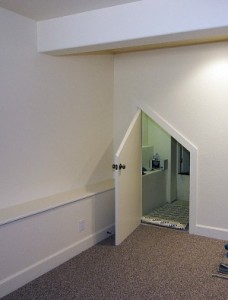Many of our foothill homes are built on sloping parcels of land. The result is often that the house sits on top of a huge crawlspace that is generally unusable. Most homeowner’s are aware of the potential to finish this bonus space, but may not know how to plan the project. There are several ways to tackle this opportunity, depending upon what sort of use you envision for the new space.
When a home is built with a large crawlspace, there is usually some attempt to provide reasonable access. Many builders will excavate a reasonably level pad in the crawlspace and provide a full size door to access the space. A light and outlet are required by code. Sometimes moisture is present, but can be addressed with good waterproofing and proper drainage.
Unfortunately, some issues that are usually overlooked are routing of plumbing pipes and heating and air ducts. Some of these can be expensive to relocate later. The floor system is usually supported by a series of posts and concrete piers, but beams can be installed to open up the space. Headroom must be greater than seven feet, preferably at least eight feet, after subtracting the thickness of a concrete slab floor.
Sometimes it is possible to find solutions to these challenges with a little engineering savvy. We recently built a new downstairs space with a family room, office and a bathroom where the initial headroom was not sufficient. The crawlspace sloped from head high to crawling on hands and knees.
The plan involved using a Bobcat tractor to excavate beneath the house. We cut a hole in the back of the house and removed a section of the foundation so the tractor could excavate and remove the excess earth from the lower half of the crawlspace. This new grade was lower than the foundation, but we engineered a solution by pouring concrete retaining wall or buttress to support the existing footings.
 In many building projects an intrusive element, like the 18” high concrete buttresses sticking out of the floor, can be adapted into a useful or pleasing feature. Although the original plan called for a false wall to cover the buttress, our lead carpenter suggested we create a built in bench to run the length of the room. With the owner’s approval we built the bench and installed a cherry laminate countertop against the window wall in both rooms to disguise the protrusion. The result is a very useful, interesting family room and office with built-in work counters located in front of windows. For this multi-generational family, it is a perfect room for the grandkids including wiring for TV, phone and computer.
In many building projects an intrusive element, like the 18” high concrete buttresses sticking out of the floor, can be adapted into a useful or pleasing feature. Although the original plan called for a false wall to cover the buttress, our lead carpenter suggested we create a built in bench to run the length of the room. With the owner’s approval we built the bench and installed a cherry laminate countertop against the window wall in both rooms to disguise the protrusion. The result is a very useful, interesting family room and office with built-in work counters located in front of windows. For this multi-generational family, it is a perfect room for the grandkids including wiring for TV, phone and computer.
Another key to a converting your crawlspace into a successful living space is to provide interior stairs to connect the two levels. The stairs should connect from common space on the main level, such as a living room or hallway. This can be a difficult proposition, as a straight stairway requires a three-foot by twelve-foot footprint.
Since this home was designed with future stairs in mind, we were able to remove some closets to do the job. We installed a single run of stairs with a generous width of 44”, which makes moving furniture easier. Other homes may use an ell-shaped stair run to do the trick. Spiral stairs should be considered as a last option. They are five foot in diameter and not very functional. If this just isn’t possible in your home, you may consider an outside set of stairs that can provide a more separate living space.
A bathroom downstairs will greatly enhance the usefulness and value of your home. We added a bathroom to this project, but the main sewer line for the home was above this level. We solved this problem by installing a sewage pump. I warn clients that during power outages they should use a different bathroom as the pump requires electricity, but the pump tank will handle one or two flushes until power returns.
This home now has a daylight basement with windows installed on the downhill wall of the house. Adequate light and ventilation is required for living space. The Uniform Building Code requires 8% of the floor area be represented in glazing (windows) and 4% for ventilation, excluding bathrooms, closets and hallways.
This means that a ten-foot by ten-foot room must have at least a two-foot by four-foot window, which is operable for ventilation. We have occasionally solved this issue by installing a light well, which involved retaining the earth away from a below grade window. These are common on the East Coast where basements are the rule not the exception.
Another reason this project was successful is that it did not take away from the original house design or site. The owners had pondered various additions to the home, but did not want “tack on” an addition, or lose landscaping or trees adjacent to their home. Converting the crawlspace was very effective use of space and gave them what they wanted conveniently. The downstairs appears in every way to be a part of the original home, which I consider one of the measures of a well-executed remodel.
Before we left the project, a slumber party with grand kids had already christened the family room. At end of the every construction project there is a transition from being building environment, which is often noisy, dirty and sometimes smelly to a comfortable home environment for family living. With a smile we appreciated the fun this family will have as we leave and the family begins to enjoy their new downstairs. They have gained two additional rooms and a bathroom. With the downstairs for grand kids to play, the adults have a quieter space upstairs at the same time.
——————————————–
Andrew Wright, CR is a regional and national award winning remodeler and a member of the National Association of the Remodeling Industry and the National Kitchen & Bath Association. He may be reached at WrightBuilt Home Remodel & Design at 530-272-6657.




